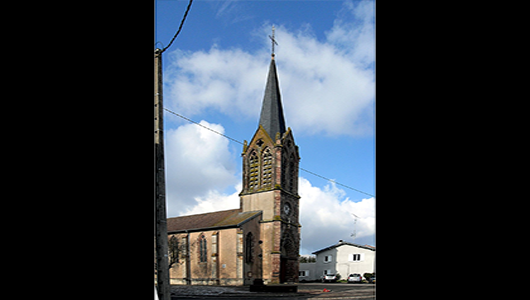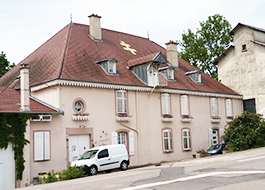Xermaménil
Durée visite : 20 minutes
Moyen : Pédestre
La première mention de ce village date du XIIe siècle.
Il passa du seigneur de Nomény à celui de Riste au XVIIIe. Les habitants de cette commune se distinguaient par un certain air de politesse et d’honnêteté. Ce qui a valu le surnom de Xermaménil-les-Monsieurs. Deux familles de Xermaménil ont donné des généraux à la France. Anatole Mangin s’illustra pendant les guerres napoléoniennes. Il participa ensuite aux expéditions d’Espagne et de Grèce, puis à la conquête de l’Algérie. En 1847, son neveu, Léon Mangin, contribuera à la Reddition d’Abd El-Kader. Il participera ensuite à la Conquête de la Kabylie. Lors de la guerre du Mexique en 1862, il fut blessé lors du siège de Puebla. Général en 1870, il est fait prisonnier à Metz.
Emile Hogard est né en 1894. Saint-Cyrien, il participe à la Première Guerre mondiale. Il s’y couvre de cicatrices et de décorations. Il poursuit sa carrière au Maroc et en Algérie. A la tête des goumiers marocains, il combat dans les Alpes et les Vosges en 1944. Mort en 1990, il est enterré dans son village. Son fils Jacques, né en 1918, est également Saint-Cyrien. Il commande des tirailleurs sénégalais en 1940. Fait prisonnier, trois fois évadé et repris, il finit la guerre au château- prison de Colditz. Capitaine en Indochine, il est considéré comme le doctrinaire de la guerre révolutionnaire. Il met ses théories de contre-insurrection en pratique en Algérie. Ce royaliste légitimiste est mort en 1999. Il est aussi inhumé à Xermaménil.
The first mention of this village dates back to the 12th century. He went from the lord of Nomény to that of Riste in the 18th century. The inhabitants of this commune were distinguished by a certain air of politeness and honesty. This earned the nickname Xermamenil-les-Monsieurs. Two families from Xermamenil gave generals to France. Anatole Mangin distinguished himself during the Napoleonic Wars. He then participated in expeditions to Spain and Greece, then to the conquest of Algeria. In 1847, his nephew, Léon Mangin, contributed to the Reddition of Abd El-Kader. He then participated in the Conquest of Kabylia. During the Mexican War in 1862, he was wounded during the siege of Puebla. General in 1870, he was taken prisoner in Metz.
Emile Hogard was born in 1894. Saint-Cyrien, he participated in the First World War. It is covered with scars and decorations. He continued his career in Morocco and Algeria. At the head of the Moroccan goumiers, he fought in the Alps and the Vosges in 1944. He died in 1990 and is buried in his village. His son Jacques, born in 1918, is also Saint-Cyrien. He commanded Senegalese gunners in 1940. Taken prisoner, escaped three times and recaptured, he ended the war at Colditz Castle-Prison. Captain in Indochina, he is considered the doctrinaire of the Revolutionary War. He puts his theories into practice in Algeria. This legitimist royalist died in 1999. He is also buried in Xermamenil.
Die erste Erwähnung dieses Dorfes stammt aus dem 12. Jahrhundert. Er ging im 18. Jahrhundert vom Herrn von Nomény zum Herrn von Riste über. Die Bewohner dieser Gemeinde zeichneten sich durch eine gewisse Höflichkeit und Ehrlichkeit aus. Dies brachte den Spitznamen Xermaménil-les-Monsieurs ein. Zwei Familien von Xermaménil gaben Generäle nach Frankreich. Anatole Mangin zeichnete sich während der Napoleonischen Kriege aus. Anschließend nahm er an den Expeditionen nach Spanien und Griechenland sowie an der Eroberung Algeriens teil. 1847 wird sein Neffe Léon Mangin zur Übergabe von Abd El-Kader beitragen. Er wird dann an der Eroberung von Kabylia teilnehmen. Während des mexikanischen Krieges 1862 wurde er während der Belagerung von Puebla verwundet. General wurde er 1870 in Metz gefangen genommen.
Emile Hogard wurde 1894 geboren. Saint-Cyrien nahm am Ersten Weltkrieg teil. Er ist mit Narben und Dekorationen bedeckt. Er setzte seine Karriere in Marokko und Algerien fort. An der Spitze der marokkanischen Goumiers kämpfte er 1944 in den Alpen und den Vogesen. Er starb 1990 und wurde in seinem Dorf beigesetzt. Sein 1918 geborener Sohn Jacques ist ebenfalls Saint-Cyrien. Er befehligte 1940 senegalesische Schützen. Gefangen genommen, dreimal geflohen und zurückerobert, beendete er den Krieg im Schlossgefängnis von Colditz. Als Kapitän in Indochina gilt er als Doktrinär des Unabhängigkeitskrieges. Er setzt seine Theorien in Algerien in die Praxis um. Dieser legitimistische Royalist starb 1999. Er ist auch in Xermaménil begraben.

De gueules au fer de moulin d’argent accosté de quatre croisettes pommetées au pied fiché de même mises en croix.
L’étymologie de Xermaménil est : le moulin de germain, d’où le fer de moulin. Quant aux croix pommetées fichées, elles rappellent que la commune faisait partie du marquisat de Gerbéviller. C’est en 1983 que la commune adopta ce blason.
From mouths to silver mill iron accosted by four pommeted crucified crucified crucified at the foot of the same cross.
The etymology of Xermaménil is: the german mill, hence the mill iron. As for the appleed crosses, they remind us that the commune was part of the Marquisat de Gerbéviller. It was in 1983 that the municipality adopted this coat of arms.
Von Dentern mit silbernen Mühleneisen, die mit vier geknoffenen Kreuzchen versehen sind, die ebenso gekreuzt sind.
Die Etymologie von Xermaménil ist: die germanische Mühle, daher das Mühleneisen. Was die registrierten Apfelkreuze betrifft, so erinnern sie daran, dass die Gemeinde Teil des Marquis de Gerbéviller war. 1983 nahm die Gemeinde dieses Wappen an.

Les habitants du lieu et des environs disaient au XIXe siècle Chmaménil, auparavant Chameni. À la même époque, les habitants de cette commune se distinguaient par un certain air de politesse et d’honnêteté qui a fait donner à cette localité le surnom de Xermaménil-les-Monsieurs.
The inhabitants of the place and the surrounding area said in the 19th century Chmamenil, formerly Chameni. At the same time, the inhabitants of this commune were distinguished by a certain air of politeness and honesty that made this town give the nickname of Xermaménil-les-Monsieurs.
Die Bewohner des Ortes und der Umgebung sagten im 19. Jahrhundert Chmaménil, zuvor Chameni. Zur gleichen Zeit zeichneten sich die Einwohner dieser Gemeinde durch eine gewisse Höflichkeit und Ehrlichkeit aus, die diesem Ort den Spitznamen Xermaménil-les-Monsieurs geben ließ.
Les points de visites
.
L’église Saint-Mansuy date du XIXe siècle. Elle est de style néo-gothique. Mansuetus était le nom latin de Saint Mansuy de Toul. Mansuetus signifie en latin doux, bienveillant, bon, paisible. Il a également généré en français le mot mansuétude. Grâce à la popularité du saint, Mansuy est ensuite devenu un nom de baptême. Il a disparu comme prénom mais persiste actuellement comme patronyme. Saint Mansuy de Toul est le premier évêque connu de cette cité. Il aurait exercé de 338 à 375, selon le texte rédigé au Xe siècle par l’écolâtre Adson. L’écolâtre était, au Moyen Âge, le maître de l’école monastique ou de l’école cathédrale. Saint Mansuy est invoqué pour la guérison des lépreux.
The church Saint-Mansuy is from the 19th century. It is neo-Gothic in style.
Mansuetus was the Latin name for Saint Mansuy de Toul. Mansuetus means sweet, benevolent, good, peaceful Latin. It also generated the word mansuétude in French. Thanks to the popularity of the saint, Mansuy then became a baptism name. It disappeared as a first name but currently persists as a surname. Saint Mansuy de Toul is the first known bishop of this city. He is said to have practiced from 338 to 375, according to the text written in the 10th century by the Adson Schoolgirl. The schoolgirl was, in the Middle Ages, the master of the monastic school or the cathedral school. Saint Mansuy is invoked for the healing of lepers.
Die Kirche Saint-Mansuy stammt aus dem 19. Jahrhundert. Sie ist im neugotischen Stil.
Mansuetus war der lateinische Name von Saint Mansuy de Toul. Mansuetus bedeutet auf sanftes Latein, wohlwollend, gut, friedlich. Er erzeugte auch auf Französisch das Wort Nachsicht. Dank der Popularität des Heiligen, Mansuy wurde dann ein Name der Taufe. Er ist als Vorname verschwunden, aber er ist immer noch als Nachname. Der heilige Mansuy de Toul ist der erste bekannte Bischof dieser Stadt. Er soll von 338 bis 375 ausgeübt haben, nach dem Text, der im 10. Jahrhundert von der Öko-Kirche Adson verfasst wurde. Das Öko-Kind war im Mittelalter der Meister der Klosterschule oder der Münsterschule. Der heilige Mansuy wird für die Heilung der Leprakranken angerufen.
.
Ce bâtiment connut plusieurs affectations. Il est attesté dès la première moitié du XVIIIe siècle. Acquis en 1809 par Sébastien Keller, propriétaire de la faïencerie de Lunéville, qui, outre la mouture du blé, y pratique le foulage du drap et la mouture du tan. Un four à plâtre est installé dans le deuxième quart du XIXe siècle. Il est de type tunnel à sole inclinée ; ce qui constitue l’unique spécimen existant dans la région de Gerbéviller. En 1840, l’ensemble est acquis par la famille Hogard, de Blainville-sur-l’Eau. Elle le consacre exclusivement à la mouture du blé. Transformé en minoterie dans le premier quart du XXe, il devient en 1981 un entrepôt commercial et une centrale hydroélectrique.
This building had several assignments. It is attested as early as the first half of the 18th century. Acquired in 1809 by Sébastien Keller, owner of the lunéville earthenware factory, who, in addition to milling wheat, practices the treading of the sheet and the grinding of the tan. A plaster oven was installed in the second quarter of the 19th century. It is of the slanted sole tunnel type; which is the only specimen in the Gerbéviller area. In 1840, the complex was acquired by the Hogard family of Blainville-sur-l’Eau. She devotes it exclusively to the grinding of wheat. Transformed into a flour mill in the first quarter of the 20th century, it became a commercial warehouse and hydroelectric power plant in 1981.
In diesem Gebäude gab es mehrere Verwendungszwecke. Es wurde bereits in der ersten Hälfte des 18. Jahrhunderts bezeugt. Erworben 1809 von Sébastien Keller, Besitzer der Kaizerei von Lunéville, der neben dem Mahlen des Weizens das Tuch und das Mahlen der Tan praktiziert. Ein Gipsofen wird im zweiten Viertel des 19. Jahrhunderts installiert. Es ist ein schräger Tunnel; Dies ist das einzige Exemplar in der Region Gerbéviller. 1840 wurde das Ganze von der Familie Hogard in Blainville-sur-l ‘Eau erworben. Sie widmet es ausschließlich der Mahlung des Weizens. Im ersten Viertel des 20. Jahrhunderts wurde es in eine Müllfabrik umgewandelt und wurde 1981 ein kommerzielles Lager und ein Wasserkraftwerk.







